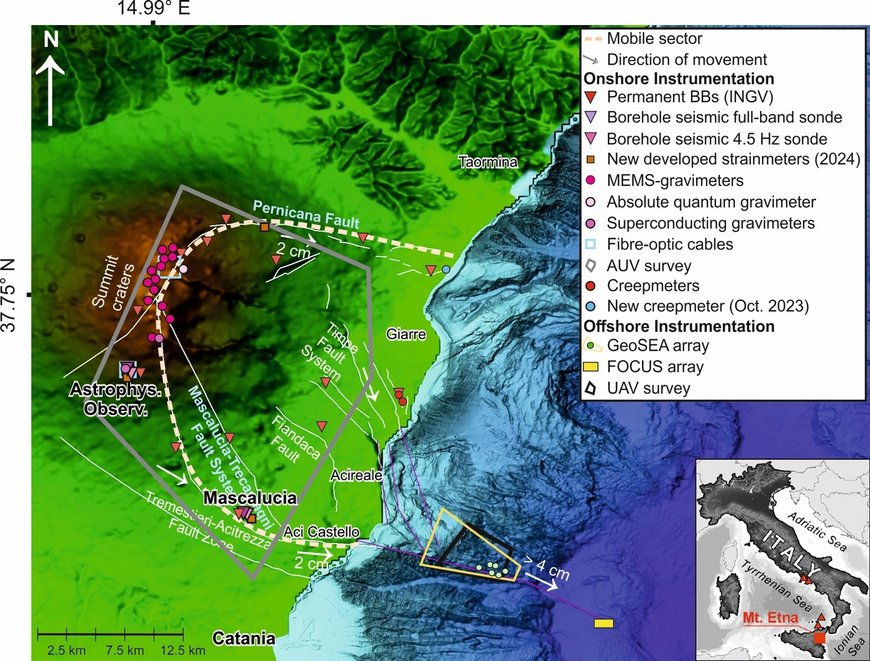Etna and southern Italy volcanoes
Italy
Mt. Etna (Eastern Sicily), located in one of the most complex tectonic environments, is one of the most active and best monitored volcanoes around the world. It is characterized by multi-hazard activity that endangers the densely populated area. Active Faults outcropping on the SE-flank are main dislocations for flank destabilization and show a range of behaviors including creep, swarm activity and seismic slip. Volcanic activity exhibits a large variability, with lava fountains, lava flows, Strombolian explosions and ash fall. Internal and external forces lead to flank instability of the eastern flank of the volcanic edifice, which is enhanced by gravity and magmatic intrusions.
The eastern to southeastern flank of Mt Etna slides into the Ionian Sea at rates of centimeters per year. Such unstable flanks could fail catastrophically, triggering landslides that could generate tsunamis. Due to this behavior, the region of Mt. Etna / Southern Italy is an ideal location, to understand the preparatory phase of hazards and to establish instrumentation at the onshore-offshore interface.
Since some aspects cannot be approached on Etna alone, our efforts also include comparisons and projects on nearby volcanic islands (Vulcano and other Eolian Islands) and the Campanian volcanoes (Vesuvius, Campi Flegrei).
Our Mission
The focus site group has been established in 2021. The various components of the focus site contribute to study the structure and dynamic of volcanoes in their geodynamic context in Southern Italy, e.g., to investigate the unstable volcanic flank of Mt. Etna. We study the underlying processes using observations and modeling from the summit to the submarine environment.
As a focus site, our mission is to establish a network of research projects that work towards the above formulated key question across disciplines. These initiatives are partially long-term monitoring efforts, but at the current stage also pilot projects to test applicability of methodologies and to contribute important underlying data sets from geological processes.
Description of instrumentation, experiments and other activities
- IVOTED-Etna: Investigation of VOlcano-TEctonic Deformation at Etna, using the very first two seismic borehole broadband sensors to monitor high resolution signals south of the SE crater and in Mascalucia close to the creeping fault section of the Mascalucia-Tremestieri-Trecastagni Fault System. The installation was part of the EU funded project “Sic nano for PicoGeo” and extends the local INGV seismic surface network. A first data publication of a seismic test dataset will be published via the GFZ Data Services end of 2023.
- Flank instability coupled to new unrest and increased hydrothermal activity, usingunoccupied aircraft systems (UAS) to map volcanic alteration zones that lead to rock weakening along the crater rim. Field surveys will be accompanied by satellite image acquisitions (SAR, EnMAP, Pleiades) to analyze volcano flank instability related to hydrothermal weakening of rocks. Volcano flank instability is a major element in the POFIV - Topic 3, and one of the main topics of collaborations between GFZ and GEOMAR.
- TopogrAphic response to VOlcanic LOading (TAVOLO), to investigate the topographic signal from volcanic loading using 10Be-derived catchment average denudation rates. Results will be combined with a viscoelastic solid-earth model to investigate long-term effects of the volcanic loading on uplift and topographic evolution in eastern Sicily.
- DDSS@Sicily, to improve understanding of volcanic and seismic phenomena in Sicily using fibre optic sensing technologies and in particular distributed dynamic strain sensing (DDSS) and associated monitoring techniques. In particular, together with our colleagues from INGV-Osservatorio Etneo,we have shown that DDSS could help in the detection of tiny signals and decipher structural features at high resolution, with dense and sensitive strain observations. Our scope covers Etna summit areas, the Eastern flank of Etna volcano, which comprises faults in urban areas, the submarine environment, and also boreholes. This aims at contributing to a better knowledge of the volcano-tectonic interaction and the dynamics of the Eastern flank (into the submarine environment) and its relation with the summit volcanic activity. We also performed DDSS measurements at Vulcano, where we have demonstrated that a fast response in case of volcanic crisis can be performed using fibre optic technologies on submarine telecom cables. In one-month records, we could record ~160 Very Long Period VLP that were detected with machine learning algorithms. We found several families of events that were interpreted as "breathing" of the hydrothermal system below the crater.
- Etna CREEP monitors fault displacement at localized active faults on the instable SE flank of Mt. Etna. Currently two instruments are installed across the Macchia Fault in the St. Leonardello Graben System close to the coastline. A third instrument will be installed across the Pernicana Fault in Fall 2023. Creepmeters can capture creep, slow slip events as well as triggered slip events from near field or far field sources and allow us to capture signals of volcano-tectonic interactions. Our instruments monitor slip with a resolution of 1 micrometer and a sampling interval of 30 s. These installations complements the GEOSEA array offshore Catania and strongly link research on flank instability onshore with the offshore GEOMAR activities within the framework of the Precollapse project.
- Wundervul is an INGV project that studies gas emissions at Vulcano by collecting previous observations, defining a conceptual model of the magmatic-hydrothermal system and carrying out numerical modelling.
- The project Newton-g developed novel instrumentation (field version of the quantum gravimeter AQG, named AQG-B, now installed at the observatory Pizzi de Neri at the summit) and new concepts and tools for joint inversions of ground deformation and gravity changes and for the interpretation of inversion results. The project is now concluded but tool development activities are still ongoing at GFZ.
- The RottnRock project is an ERC synergy project that aims to investigate hydrothermal activity and alteration of volcanic rocks in the context of flank instability. The development of weak flanks, shear zones and decollements is strongly related to rock alteration. At this focus site we investigate this feedback using remote sensing, field experiments, rock analysis and numerical modeling.


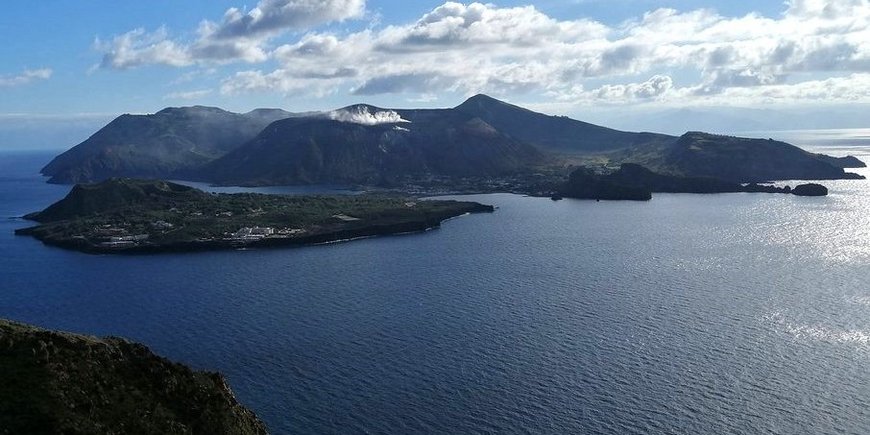
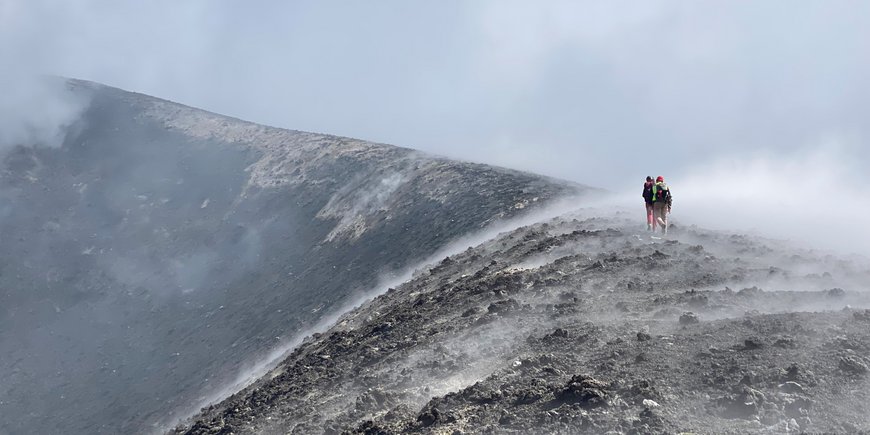
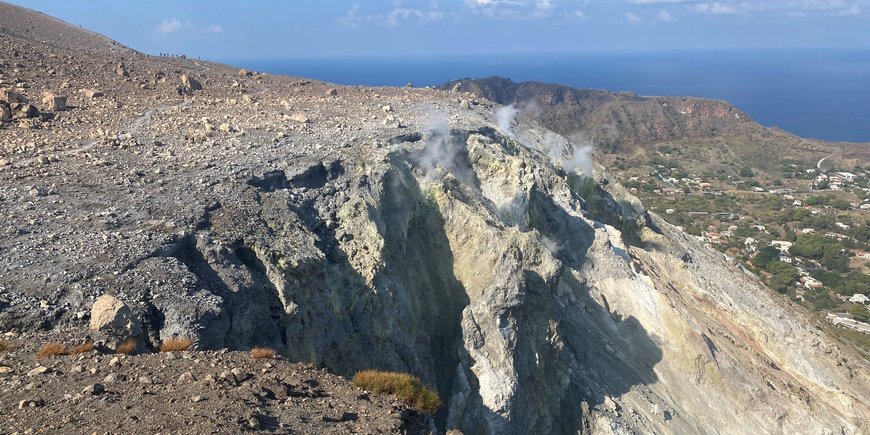
![[Translate to English:] Forscher auf dem Vulkan Ätna mit Notizblock schreibend, im Hintergrund Aschewolken des Vulkans](/fileadmin/_processed_/a/1/csm_3_8138016b3a.jpeg)
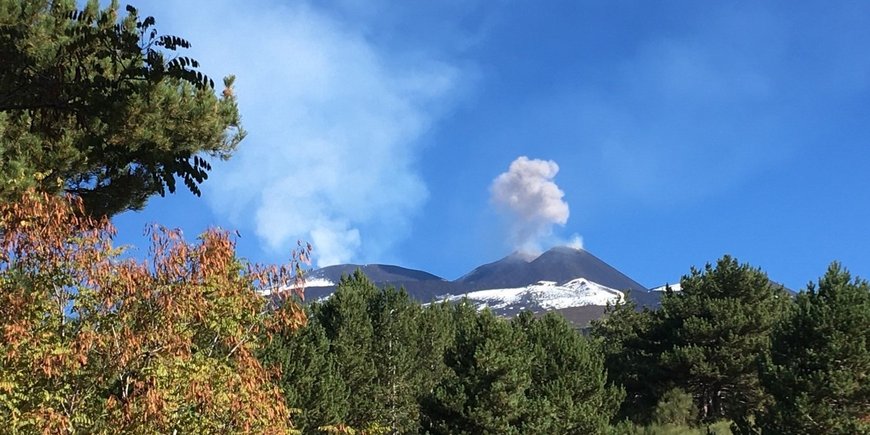
![[Translate to English:] kleiner Riss in der Erde](/fileadmin/_processed_/1/b/csm_2_db31687af5.jpeg)
